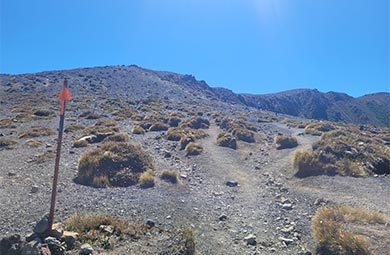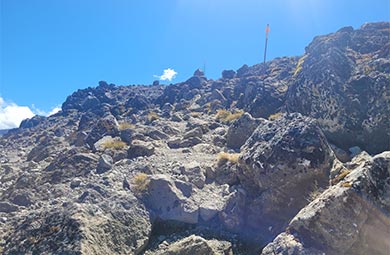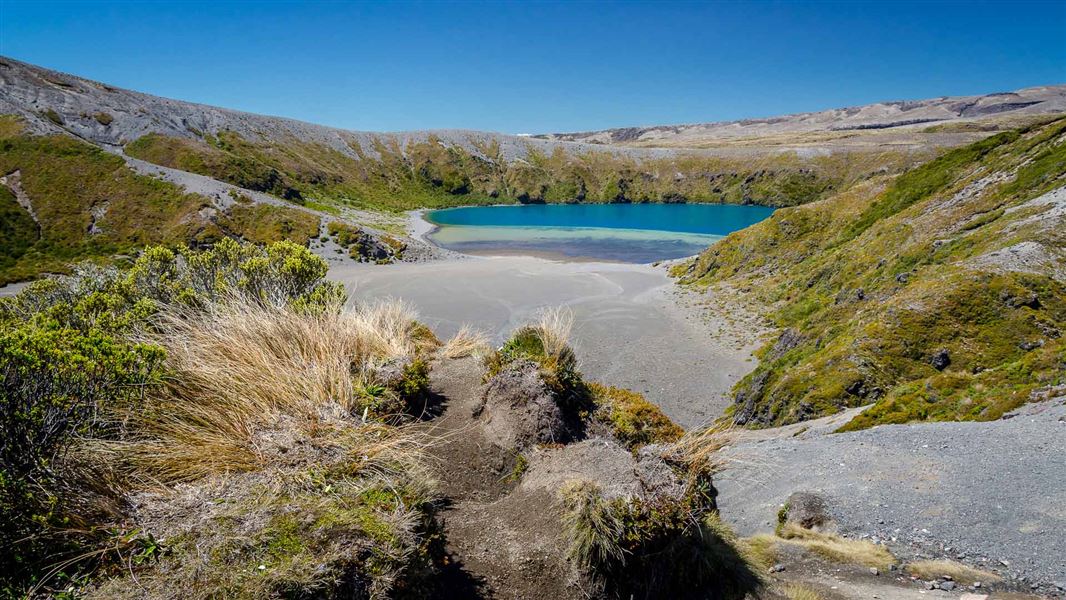17. 6 km return via same track
Winter alpine skills and equipment needed for the side trip to the Upper Tama Lake lookout when snow and ice are present.
Image gallery
Start this track from Whakapapa Village, on the Taranaki Falls Walking Track.
After reaching Taranaki Falls, the track crosses undulating tussock country and alpine herb fields on a well-formed and marked track.
The track ends at a wide, flat clearing on Tama Saddle, with spectacular views of Lower Tama Lake, Mt Ngauruhoe and Mt Ruapehu. There is a toilet 10 minutes back down the track, near the junction with the Tongariro Northern Circuit Great Walk.
This track requires less uphill walking and exposure to alpine weather than the Tongariro Alpine Crossing. It can be a great alternative. However, it is still an alpine environment and can be difficult in bad weather. Talk to the Tongariro National Park Visitor Centre about the current conditions.
There are no formed tracks down to Lower or Upper Tama Lakes, as the gullies leading down to them are steep and unstable. To ensure these pristine alpine lakes are kept free of weeds, do not touch or swim in the water.
Side trip to Upper Tama Lake viewpoint
 Steep and challenging terrain on the side track to Upper Tama Lake viewpoint.
Steep and challenging terrain on the side track to Upper Tama Lake viewpoint.
Image: Theo Chapman | DOC
 Steep and challenging terrain on the side track to Upper Tama Lake viewpoint.
Steep and challenging terrain on the side track to Upper Tama Lake viewpoint.
Image: Theo Chapman | DOC
Time: 35 minutes (one way)
Distance: 1.4 km
Track grade: Advanced tramping track
There is a rough, unformed route from the end of the Tama Lakes Track to Upper Tama Lake viewpoint. This is an advanced tramping track and is much more challenging than the main Tama Lakes Track.
The route climbs steeply up a ridge to a viewpoint of Upper Tama Lake. The track is not formed and is made of loose and uneven rock. It is unstable and slippery.
There is no shelter, the weather changes fast and the wind is often very strong. Low cloud can make it hard to follow the route. In winter, you may need winter alpine skills and equipment due to snow, ice and avalanche risk.
The walk starts at Whakapapa Village on SH48. Start on the Taranaki Falls Walking Track, 100 m below the Tongariro National Park Visitor Centre on Ngauruhoe Place.
Be ready for alpine weather
Strong wind, heavy rainfall and rapid changes in temperature are common in Tongariro National Park, even in summer. Check the weather forecast before heading out. Always carry warm, waterproof and windproof clothing.
Weather forecast
Upper Tama Lake weather forecast – NIWA website
The side trip to Upper Tama Lake viewpoint is much more difficult than the main track
The route beyond Lower Tama Lake is unformed and follows the natural ridgeline. It is much rougher and more exposed than the main Tama Lakes Track and is only suitable for fit and confident hikers.
Only attempt this track if you are confident walking on loose rocks and descending back down the ridge on an unstable, slippery surface.
Do not hike this side track if the weather is bad or there is low cloud. Low cloud decreases visibility, making navigation difficult and increasing the chance that you will get lost. This area is very exposed and there is no shelter from the weather.
Winter alpine skills may be needed on the side trip to Upper Tama Lake viewpoint
Do not hike the side trip to Upper Tama Lake viewpoint when snow and ice are present unless you have winter alpine skills and equipment.
You must:
- know how to navigate if cloud or snow covers the marker poles and you cannot see them
- have the equipment and skills to prevent a slide on icy terrain
- have the clothing for sub-zero temperatures and be able to survive if the weather gets worse
- know where avalanches are a risk and be able to rescue someone if an avalanche occurs. There is challenging avalanche terrain between Upper and Lower Tama Lakes. Crampons, an ice axe and avalanche rescue equipment are essential, as well as the skills to use them. For the current avalanche danger rating, check the New Zealand Avalanche Advisory forecast for the Tongariro area
 No unauthorised drone use in the national park
No unauthorised drone use in the national park
Unauthorised use of drones is prohibited. You must have a permit to fly a drone.
DOC does not generally approve permits to fly drones in this national park and we do not recommend you apply for one.
There was an explosive eruption period around 10,000 years ago in Tongariro National Park. It created craters, several of which later filled with water and became Tama Lakes.
Some of the oldest lava flows on the slopes of Ruapehu and Tongariro can be found at the Tama Saddle. Some are up to 275,000 years old and can be seen in the cliffs near Lower Tama Lake.
Stay safe in the outdoors
- Choose the right trip for you. Learn about the route and make sure you have the skills for it.
- Understand the weather. Check weather forecasts.
- Pack warm clothes and extra food. Check gear lists.
- Share your plans and take ways to get help. Leave your intentions with a trusted contact and take a distress beacon.
- Take care of yourself and each other.
Tongariro National Park Visitor Centre
| Phone: | +64 7 892 3729 |
| Email: | tongarirovc@doc.govt.nz |
| Address: | Whakapapa Village State Highway 48 Mount Ruapehu 3951 |
| Hours: | Visitor centre hours and services |
